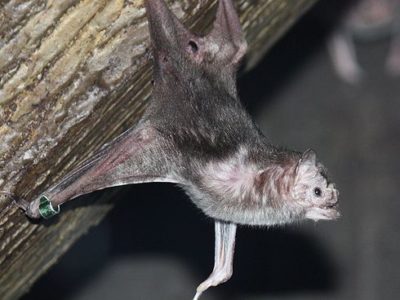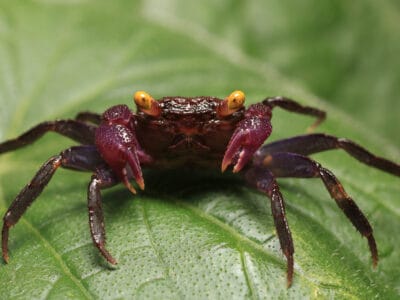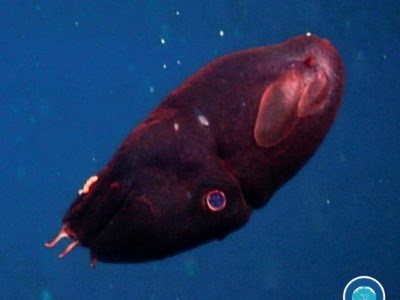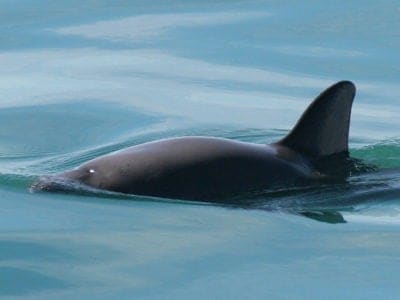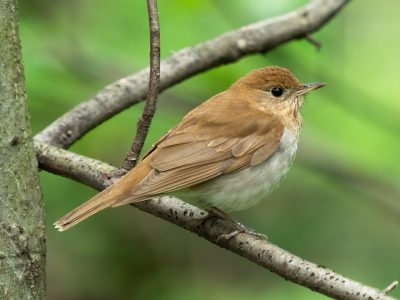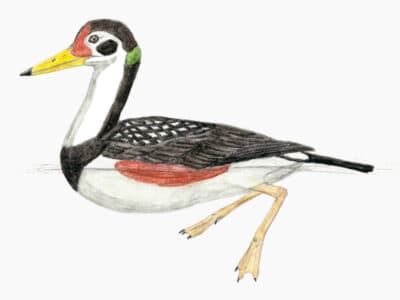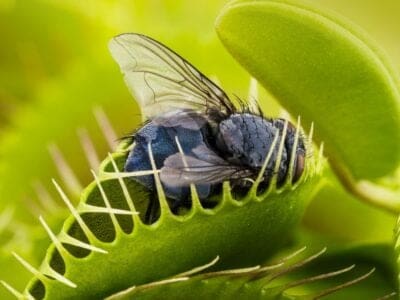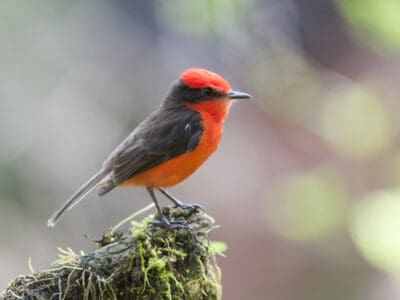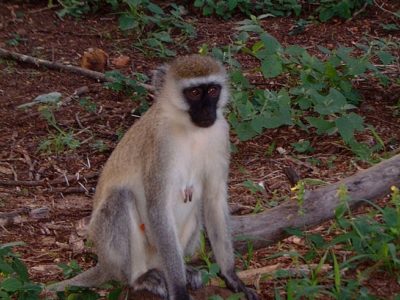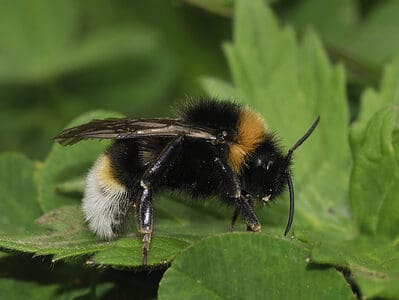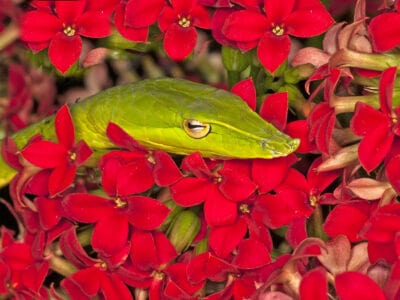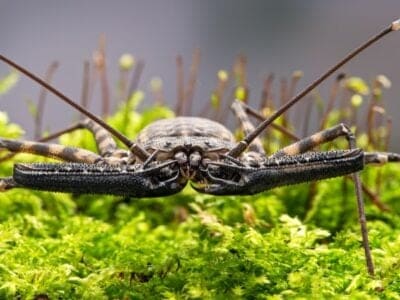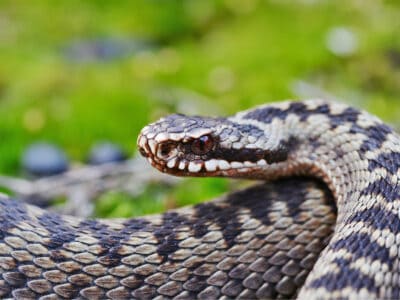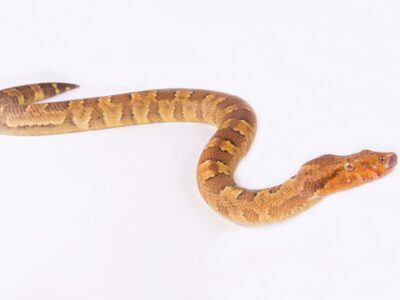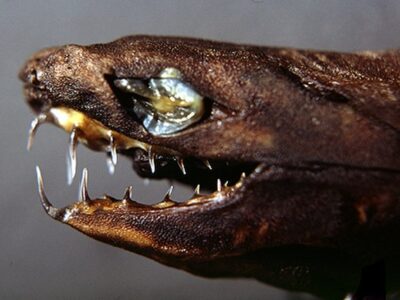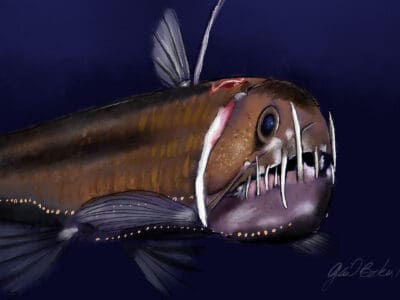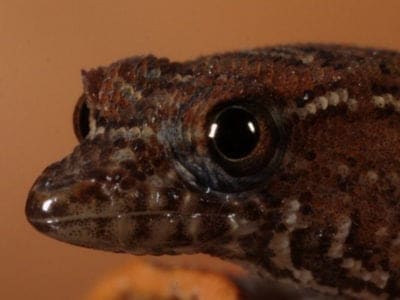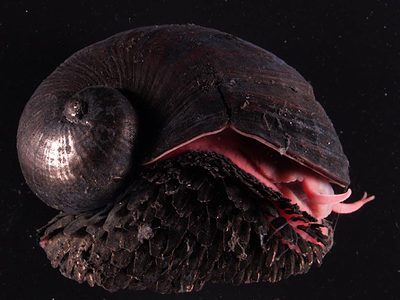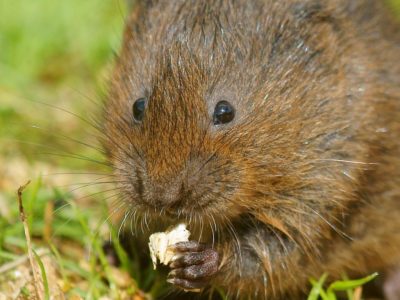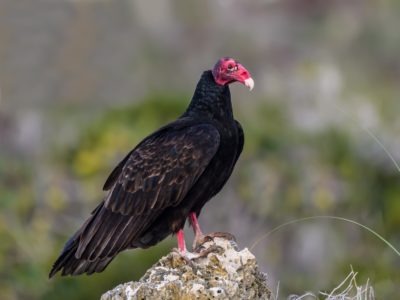Read below for information on 25 different animals that start with the letter V. They are the vampire bat, the vervet monkey, and vulture. Vampire bats are nocturnal and have razor sharp teeth. Vervets are mostly tree dwelling animals. The vulture is a carnivorous bird that is widely distributed across the world. AZ Animals will be covering many more V name animals soon.
Jump to any letter
Alphabetical List of Animals That Start with V
All Animals that Start with V
Valley Bulldog
- Kingdom
- Animalia
- Phylum
- Chordata
- Class
- Mammalia
- Order
- Carnivora
- Family
- Canidae
- Genus
- Canis
- Scientific Name
- Canis familiaris
Fun Fact: These dogs cannot swim well because of their stocky build and short legs.
The Valley Bulldog originated in Nova Scotia, situated in Canada. This breed has a mixture between a boxer and an English bulldog. Although a rare breed, they are still known to be very popular and a common sight. These dogs have been around since the mid-1990s, but some believe the Valley bulldog may have been […] Read More
Vampire Bat
- Kingdom
- Animalia
- Phylum
- Chordata
- Class
- Mammalia
- Order
- Chiroptera
- Family
- Phyllostomidae
- Scientific Name
- Desmodontinae
Fun Fact: Have a heat sensor on the end of their nose!
Classification and Evolution Vampire bats are a small subgroup of bat native to Central and South America. There are three recognized species of Vampire Bat, all of which also belong to a genus all their own. The Common Vampire Bat, the Hairy-Legged Vampire Bat, and the White-Winged Vampire Bat are all closely related and share […] Read More
Vampire Crab
- Kingdom
- Animalia
- Phylum
- Arthropoda
- Class
- Malacostraca
- Order
- Decapoda
- Family
- Sesarmidae
- Genus
- Geosesarma
- Scientific Name
- Geosesarma dennerle
Fun Fact: Vampire crabs do not depend on saltwater for their development; instead, they live near freshwater rivers and in forests amongst rocks and dense vegetation.
Vampire crabs do not depend on saltwater for their development; instead, they live near freshwater rivers and in forests amongst rocks and dense vegetation. This tiny crab is one of the most popular tank pets these days, and everybody wants one. While vampire crabs don’t feed on blood as their name entails, they are nocturnal […] Read More
Vampire Squid
- Kingdom
- Animalia
- Phylum
- Mollusca
- Class
- Cephalopoda
- Order
- Vampyromorphida
- Family
- Vampyroteuthidae
- Genus
- Vampyroteuthis
- Scientific Name
- Vampyroteuthis infernalis
Fun Fact: Each of its eight arms has spines, though they use two filaments to eat.
The vampire squid is a small cephalopod and is found in tropical as well as temperate oceans. They usually exist in the deep seas and use bioluminescent organs and oxygen metabolism to survive parts of the sea that have extremely low levels of oxygen. This sea creature resembles both squid and an octopus. However, it […] Read More
Vaquita
- Kingdom
- Animalia
- Phylum
- Chordata
- Class
- Mammalia
- Order
- Artiodactyla
- Family
- Phocoenidae
- Genus
- Phocoena
- Scientific Name
- Phocoena sinus
Fun Fact: Smallest cetacean in the ocean
Summary The vaquita holds several records among its fellow cetaceans, including that of the smallest and rarest of all known marine mammals. This porpoise species was only recently discovered and cataloged by researchers, who didn’t have a life specimen to study until the 1980s. Vaquitas are animals that are only found in a small area […] Read More
Veery
- Kingdom
- Animalia
- Phylum
- Chordata
- Class
- Aves
- Order
- Passeriformes
- Family
- Turdidae
- Genus
- Catharus
- Scientific Name
- Catharus fuscescens
Fun Fact: The veery is named for its sharp "veer" call.
Veery Summary “The veery is named for its sharp ‘veer’ call.” The veery thrush, also known just as the veery, is a small, migratory species of songbird. It is found in both North America and South America, though its exact location depends on the time of year. They are mainly insectivores. Occasionally, however, the veery […] Read More
Vegavis
- Kingdom
- Animalia
- Phylum
- Chordata
- Class
- Aves
- Order
- Vegaviiformes
- Family
- Vegaviidae
- Genus
- Vegavis
- Scientific Name
- Vegavis iaai
Fun Fact: Vegavis was one of the earliest birds to have a sound-producing organ
Vegavis is a genus of extinct birds that lived in present-day Antarctica during the Late Cretaceous Period (Maastrichtian stage) about 66 million years ago. The extinct bird belongs to the Vegaviidae family, a group distantly related to modern ducks and geese. Scientists believe it was the earliest Mesozoic bird to have a sound-producing organ. The […] Read More
Velociraptor
- Kingdom
- Animalia
- Phylum
- Chordata
- Family
- Dromaeosauridae
- Genus
- Velociraptor
- Scientific Name
- Velociraptor mongolienses, Velociraptor osmolskae
Fun Fact:
What dinosaur was named the “swift seizer” and had a vicious hindfoot claw that could tear into its vulnerable prey? With appearances in everything from Jurassic World to memes, the Velociraptor is one of the best-known dinosaurs. “Small but vicious” accurately describes the Velociraptor. Standing hunched forward, these speedy carnivores didn’t let their smaller size […] Read More
Venus Flytrap
- Kingdom
- Plantae
- Phylum
- Tracheophyta
- Class
- Magnoliopsida
- Order
- Caryophyllales
- Family
- Droseraceae
- Genus
- Dionaea
- Scientific Name
- Dionaea muscipula
Fun Fact: The Venus flytrap is among a group of plants that consumes animals
The Venus flytrap is among a group of plants that derives some of its nutrients from eating animals. This species may look like an anomaly, unlike anything else on the planet, but it is actually just a simple flowering plant that evolved the ability to trap and then digest more complex organic matter. While it […] Read More
Vermilion Flycatcher
- Kingdom
- Animalia
- Phylum
- Chordata
- Class
- Aves
- Order
- Passeriformes
- Family
- Tyrannidae
- Genus
- Pyrocephalus
- Scientific Name
- Pyrocephalus obscurus
Fun Fact: They have a fast song that lasts up to 10 syllables at max.
The Vermilion Flycatcher is a type of perching bird that is found in South America and some parts of North America. The males differ from the females in terms of color. The males are more vibrant in color, making the females harder to identify. They have a unique singing voice that is variable but quite […] Read More
Vervet Monkey
- Kingdom
- Animalia
- Phylum
- Chordata
- Class
- Mammalia
- Order
- Primates
- Family
- Cercopithecidae
- Genus
- Chlorocebus
- Scientific Name
- Chlorocebus pygerythrus
Fun Fact: Rarely found more than 450m from trees!
Classification And Evolution The Vervet Monkey is a medium to large-sized monkey that is primarily found in Eastern Africa and is an old-world monkey. The Vervet Monkey is thought to be a species of Grivet, another tree-dwelling African monkey that has very similar characteristics to the Vervet, along with the Malbrouck, which is considered by […] Read More
Vestal Cuckoo Bumblebee
- Kingdom
- Animalia
- Phylum
- Arthropoda
- Class
- Insecta
- Order
- Hymenoptera
- Family
- Apidae
- Genus
- Bombus
- Scientific Name
- Bombus vestalis
Fun Fact: N/A
The vestal cuckoo bumblebee (Bombus vestalis), also known as the Southern cuckoo bumblebee, is a parasitic bee that lives in and around the Medeterrian, including Northern Africa, and Europe, where Its range extends north to Sweden. Vestal cuckoos also live in Western Asia. Because of evolutionary adaptations, vestal cuckoo bumblebees are not able to construct […] Read More
Vicuña
- Kingdom
- Animalia
- Phylum
- Chordata
- Class
- Mammalia
- Order
- Artiodactyla
- Family
- Camelidae
- Genus
- Lama
- Scientific Name
- Lama vicugna
Fun Fact: Vicuñas have some of the softest wool in the entire animal kingdom
“The vicuña produces some of the finest wool in the world.“ A member of the camel family, the vicuña is perhaps lesser known than its close llama and alpaca relatives, but their fur has been used to make clothing for thousands of years. In the wild, this wool helps the animal survive in the frigid […] Read More
Vine Snake
- Kingdom
- Animalia
- Phylum
- Chordata
- Class
- Reptilia
- Order
- Squamata
- Family
- Colubridae
Fun Fact: A slender body and elongated snout give the vine snake a regal look.
A slender body and elongated snout give the vine snake a regal look. The vine snake is found in Asia, Africa, and the Americas. While all species of the vine snake have some form of venom they use on their prey, only the twig snake of Africa is harmful to humans. Bites from other species […] Read More
Vinegaroon
- Kingdom
- Animalia
- Phylum
- Arthropoda
- Class
- Arachnida
- Order
- Thelyphonida
- Family
- Thelyphonidae
Fun Fact: Vinegaroons can spray 19 times before the glands are depleted
“A scary-looking, but a harmless, cousin of the spider.” With 120 species in 16 genera, the vinegaroon, or whip scorpion is found in the warmer places of the world save Australia and Europe. Admittedly, it is not everyone’s favorite animal and, if scaled up to be about as big as a horse, would be a […] Read More
Viper
- Kingdom
- Animalia
- Phylum
- Chordata
- Class
- Reptilia
- Order
- Squamata
- Family
- Viperinae
- Genus
- Various
Fun Fact: Vipers are one of the most widespread groups of snakes and inhabit most
Vipers are a large subfamily of venomous snakes in the Viperidae family of the class Reptilia. They inhabit most of continental Europe, Asia, and Africa and are responsible for a large number of snakebites in those areas. Vipers are diverse and highly evolved, with retractable fangs and large venom glands. Incredible Facts About Vipers There […] Read More
Viper Boa
- Kingdom
- Animalia
- Phylum
- Chordata
- Class
- Reptilia
- Order
- Squamata
- Family
- Boidae
- Genus
- Candoia
- Scientific Name
- Candoia aspera
Fun Fact: These boas aren't really vipers, they're nonvenomous constrictors that look like vipers.
Dubbed the “lazy snake” by locals, the viper boa is slow-moving, even by boa standards. These nonvenomous constrictors are nocturnal and native to New Guinea and several of the surrounding islands. Their small stature and beautiful colors make them loved by keepers, even though they’re rare in captivity, and it’s hard to find captive-bred individuals. […] Read More
Viper Shark (dogfish)
- Kingdom
- Animalia
- Phylum
- Chordata
- Class
- Chondrichthyes
- Order
- Squaliformes
- Family
- Etmopteridae
- Genus
- Trigonognathus
- Scientific Name
- Trigonognathus kabeyai
Fun Fact: Most data on these fish is based on observations near Japan.
The viper shark, also known as the viper dogfish, is an elusive creature that swims no higher than 490 feet below sea level. His threatening fangs impale his prey, though the jaw is large enough to swallow many fish whole. With a sleek, black body, he easily is concealed from the bigeye tuna that hunts […] Read More
Viperfish
- Kingdom
- Animalia
- Phylum
- Chordata
- Class
- Actinopterygii
- Order
- Stomiiformes
- Family
- Stomiidae
- Genus
- Chauliodus
- Scientific Name
- Chauliodus sp.
Fun Fact: Viperfish have a bioluminescent spine on their dorsal fin.
The viperfish is a highly specialized deep-sea predator and is found all over the world’s oceans. Most of these creepy-looking fish almost never come to the surface of the ocean and stay several hundred or thousands of feet below the surface. Some catch their prey by swimming really fast and impaling their victim, but very […] Read More
Virgin Islands Dwarf Gecko
- Kingdom
- Animalia
- Phylum
- Chordata
- Class
- Reptilia
- Order
- Squamata
- Family
- Sphaerodactylidae
- Genus
- Sphaerodactylus
- Scientific Name
- Sphaerodactylus parthenopion
Fun Fact: The Virgin Islands dwarf gecko is among the smallest reptiles in the world
The Virgin Islands dwarf gecko is one of the smallest reptiles in the world. First discovered in 1964, this unique lizard is thought to inhabit several islands of the British Virgin Islands archipelago, but because it spends most of its day hiding under rocks and other objects, this species is elusive and rarely seen. Since […] Read More
Vizsla
- Kingdom
- Animalia
- Phylum
- Chordata
- Class
- Mammalia
- Order
- Carnivora
- Family
- Canidae
- Genus
- Canis
- Scientific Name
- Canis lupus
Fun Fact: Vizsla means searcher or tracker in Hungarian
The Vizsla hunts down its quarry by pointing with its snout. For this reason, it’s also called the Hungarian Pointer. The Vizsla is a sleek hunting dog, an excellent tracker, and perhaps the most famous canine export from Hungary. The history of the Vizsla dates back to the 800s AD when a nomadic people called […] Read More
Volcano Snail
- Kingdom
- Animalia
- Phylum
- Mollusca
- Class
- Gastropoda
- Order
- Neomphalida
- Family
- Peltospiridae
- Genus
- Chrysomallon
- Scientific Name
- Chrysomallon squamiferum
Fun Fact: The volcano snail lives comfortably in temperatures of up to 750 degrees Fahrenheit.
The volcano snail lives comfortably in temperatures of up to 750 degrees Fahrenheit. Facts The volcano snail is the only animal on earth whose body is made up of mineralized iron.You can pick up a volcano snail with a magnet.The volcano snail can withstand temperatures of up to 750 degrees Fahrenheit.The volcano snail could go […] Read More
Vole
- Kingdom
- Animalia
- Phylum
- Chordata
- Class
- Mammalia
- Order
- Rodentia
- Family
- Cricetidae
- Genus
- Microtus
Fun Fact: Voles were heavily mentioned in a Star Trek series as a space station pest.
Voles are small rodents that heavily resemble house mice, lemmings, and shrews. They are burrowing creatures and live in a wide range of habitats. These chunky little animals might be adorable, but they can cause a great deal of stress for gardeners. Quick Vole Facts Voles look almost exactly like mice and often get mistaken […] Read More
Volpino Italiano
- Kingdom
- Animalia
- Phylum
- Chordata
- Class
- Mammalia
- Order
- Carnivora
- Family
- Canidae
- Genus
- Canis
- Scientific Name
- Canis lupus
Fun Fact: Almost went extinct before American Eskimo Dog breeders showed interest.
The origins of the Volpino Italiano date back to ancient Europe, allowing nobles to have a companion and watchdog in a small package. The breed beat extinction in the 1980s as the result of efforts by Enrico Franceschetti and the Italian Kennel Club. Straight from Italy, the Volpino Italiano isn’t quite as popular as some […] Read More
Vulture
- Kingdom
- Animalia
- Phylum
- Chordata
- Class
- Aves
- Order
- Cathartiformes
- Family
- Cathartidae
- Genus
- Cathartes
- Scientific Name
- Cathartes aura
Fun Fact: There are 30 different species worldwide!
The vulture is one of the world’s most common scavengers The fearsome-looking vulture is often regarded by people as a nuisance or portent of death, but the birds are actually an integral part of the natural ecosystem. By opportunistically feeding on whatever remains from other animals’ kills, these scavenger birds clean up dead animal matter […] Read More
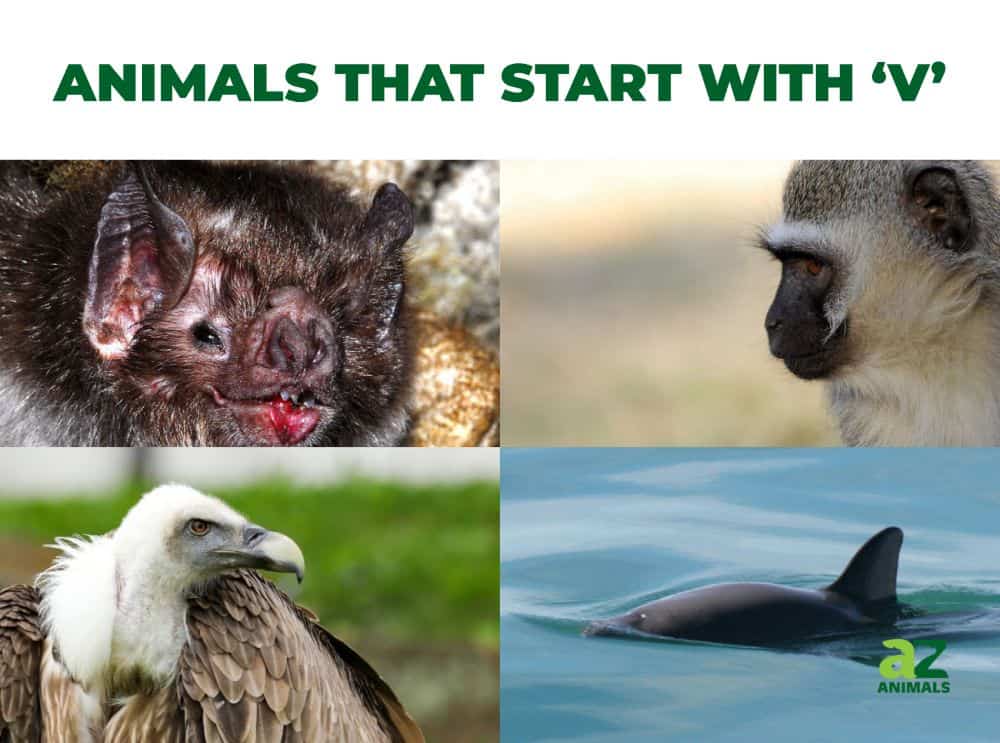
Animal by Letter Lists
- Animals that Start with A
- Animals that Start with B
- Animals that Start with C
- Animals that Start with D
- Animals that Start with E
- Animals that Start with F
- Animals that Start with G
- Animals that Start with H
- Animals that Start with I
- Animals that Start with J
- Animals that Start with K
- Animals that Start with L
- Animals that Start with M
- Animals that Start with N
- Animals that Start with O
- Animals that Start with P
- Animals that Start with Q
- Animals that Start with R
- Animals that Start with S
- Animals that Start with T
- Animals that Start with U
- Animals that Start with V
- Animals that Start with W
- Animals that Start with X
- Animals that Start with Y
- Animals that Start with Z
Thank you for reading! Have some feedback for us? Contact the AZ Animals editorial team.




